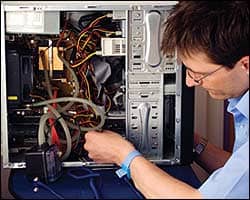 |
Many managers complain that their workers do not use their time effectively. Many workers complain that their managers have no clue as to what is involved with repairs and inspections on many devices. Both look at each other saying the blame for missed deadlines is the other’s fault. What it may actually be is that neither group understands what the other group requires. Over the years, many management plans have been introduced, and here is a brief review of two of the more common ones.
Management by Objective—which soon became Management by Obstruction, because doing the paperwork was more time-consuming than doing the actual work. Elaborate schedules were drawn up for work to be completed—generally by some one who never actually did the work—and were passed on as “This is how we do it now, so make it happen.” This type of micromanaging does not work in health care, period, and is a waste of time.
Then there was benchmarking. If department A can do all its preventive maintenance (PM) in X amount of time, then department B should be able to do the same. Generally, no one looked at the differences in the equipment in question, its age, or repair history. “If they can do it, so can we” became the mantra.
The biomed shop is not a production floor or a sales operation, but a support service where response time is critical. Our goals must be the patient’s life and not the bottom line or the bonuses that can be made. Yes, the bottom line is important, but if the patient does not get the care needed, the hospital or clinic’s bottom line will suffer more. That being said, what can we do to manage our time better?
Take Action
The first step to effective time management is to review and update the department’s policies and procedures—both the formal ones presented to The Joint Commission and the actual ones followed by the department. They probably do not agree, and many may be years out of date, so bring everything into the 21st century before going any farther. If you cannot make the changes, you have more problems than can be addressed in this article.
The next step is to realize that just because you and others are there for 8 hours a day that you do not get 8 hours of productivity. Too many people consider time management and productivity the same, but they are not. The hospital is not an assembly line, and work requirements are not steady, but sporadic—and often very pressing when a patient is involved. Look over your time sheets, work orders, and other documentation for several months to get a good idea of how many problems are handled per day per person. Also, remember to take into account that many of us are not careful and do not record tasks that take only a few minutes to do.
You also have to look at your boomerangs to determine why they happen and who has the most. If a person has great numbers of closed work orders or tests completed but a high rate of boomerangs, then time management is not there. This situation is something that will have to be addressed in your time-management evaluation, along with some training for the people involved.
Now look at the work styles of the people in the department. These styles probably range from Speedy Gonzalez to dearly beloved. Fast is not always good, and slow is not always bad. You have to look at the final product—patient safety and satisfaction—not just the numbers. You may not want to try to speed up the slow person or slow down the fast one if they are both doing a good job. Everyone works at different speeds. As long as all are doing their best, don’t mess with their speed.
Next take a look at the nonwork habits of the department. Do team members understand what it means to start work at 8 and not just be there at 8? Do they understand that there are times for breaks and lunch, and that 4:30 means 4:30 and not, “Any time after 3 is close enough for today”? If they show up at 8, then go to breakfast, and then read the sports section, they have lost an hour when they could have been doing something productive. This needs to be addressed in annual performance reviews, not as a department directive.
Priorities and Other Tips
To have good time management, you also have to have the proper tools and test equipment in the quantities needed. This can be costly at the outset, but it pays off in the long run. If someone has to wait for a test device, he or she is probably not going to be doing much else until that device becomes available.
You also need to prioritize what gets done and in which order. Some people like to do the “low-value” tasks early in the day, and others like to start with the high-value tasks. Remember, C. Northgate Parkinson once wrote that, “The job will expand to fill the time allotted to it.” As the comedian Larry the Cable Guy says, “Git-R-Done” and move on. Find what works best and stick with it. Some days you just want to do the simple tasks, so get them done that day and then you can concentrate on the more difficult ones the next day. Whatever your choice, always remember that when the beeper goes off with a real-time problem, that is what has to get done, and done quickly. This is where your time management must be most effective.
Other factors to consider when evaluating how to improve time management include:
- How far from the shop are your customers? Travel time can be longer than repair time. Is the travel time giving your customers the impression that you have bad time-management skills?
- What do you have for spares? The spare monitor for the ICU should be kept close to the ICU and not in the shop if there is considerable distance between them.
- Do you keep an inventory of repair items, or is everything ordered when needed? Waiting for parts can give the customer the impression that you are not capable of handling the problem, and can cost the hospital some serious money if a bed has to be closed or tests postponed. Next-day air delivery should be used to get the part in if a unit is down and no spare is available.
- Can you cut a purchase order (PO) for a part? If not, how long does it take to get a PO for a repair part? This can also give your customers the impression that you practice bad time management.
- What are your communication methods with others in the department? E-mail is nice, but talking face to face is much better. The results are quicker, and it is always possible that the problem has been corrected already. Encourage everyone to communicate the status of anything they are working on and also where they are headed, because there could be another problem in the same general area that they can look at before or after.
- Encourage the use of to-do lists by everyone to keep staff on track.
- If you have or are a wanderer, try to break that habit. Sometimes the to-do list is a great first step in helping to change that habit.
- Make rounds on a Friday afternoon to all your critical areas that may call for assistance over the weekend. Correct the small problems then, not at 3 am.
- Set reasonable personal and departmental goals. Once you start to hit those goals, it is easier and more rewarding to increase the goals. Too many failures generally result in employees losing interest in the project/program.
- Communicate, communicate, communicate, remembering that your present problem was probably solved by someone else and he or she might be willing to share knowledge.
Finally, keep in mind that improving time management is a continuing process. It takes time to better manage time, so do not look for major changes in a short period of time. There is no magic system for time management. You continually have to adjust, add, delete, and think about what you do and what needs to be done, keeping in mind that the ultimate goal is the patient, not some magic number or process set by someone else.
David Harrington, PhD, is director of staff development and training at Technology in Medicine (TiM), Holliston, Mass, and is a member of 24×7‘s editorial advisory board. For more information, contact .
In Search of (a Way to Avoid) Lost Time
As reliably as hands on the clock tick minutes into hours, more time-sensitive matters will pop up, blocking the task at hand. Putting the original task off because something more pressing has to be handled is inherent in the clinical and biomedical engineering profession. Putting something off because it’s not fun is inherent in human nature—and can be avoided with some simple tips.
Pace Productivity, Toronto, a company that trains employees and conducts job analysis studies to inspire people to improve their results through the better use of time, points out that to do away with procrastination, first you have to understand the cause of it and develop strategies to fix it. Procrastination does not just exist when the day’s beginning and that sports section is waiting to be read.
According to the company, procrastination stems from habit, so making new habits will be essential, but this does take time and commitment to develop. Pace encourages clients to recognize the difference between an appropriate decision to delay a task at hand, and an irrational postponement that has no justification. To get you going, Pace suggests giving yourself a small reward for getting larger tasks done, but cautions that if you know you don’t deserve the reward, whether it’s a nice lunch or a Twinkie, don’t take it.
Another tip is to break ominously large jobs into smaller, more manageable tasks, or make a game out of unpleasant tasks, awarding yourself points as you progress through the work.
For the never-ending paperwork, create a block of time during nonprime hours to handle it. Schedule this in your day and stick to it.
Anything can work as a distraction when you are facing a job that is less than desirable. The consulting firm recommends that you tailor your environment for work. Close the door, clean up the clutter on your desk, and remove distractions such as water coolers, snacks, and magazine racks. If drop-in visitors who just want to talk present a problem, stand up when someone walks in to talk to you, which will make it less likely that your visitor will sit down and get comfortable.
Technology, for all its help in getting the job done, can also serve as a hindrance to getting the job started. Excessive e-mailing can steal time, as well as cell phone calls. Pace recommends turning personal cell phones off during the day. If there is an emergency, people will know how to reach you.
At the end of the day, keep in mind that your goal is to better serve the organization. What may benefit you as an individual may be detrimental to the team, so be careful that your tactics are not counterproductive.
—Zach Dillon




